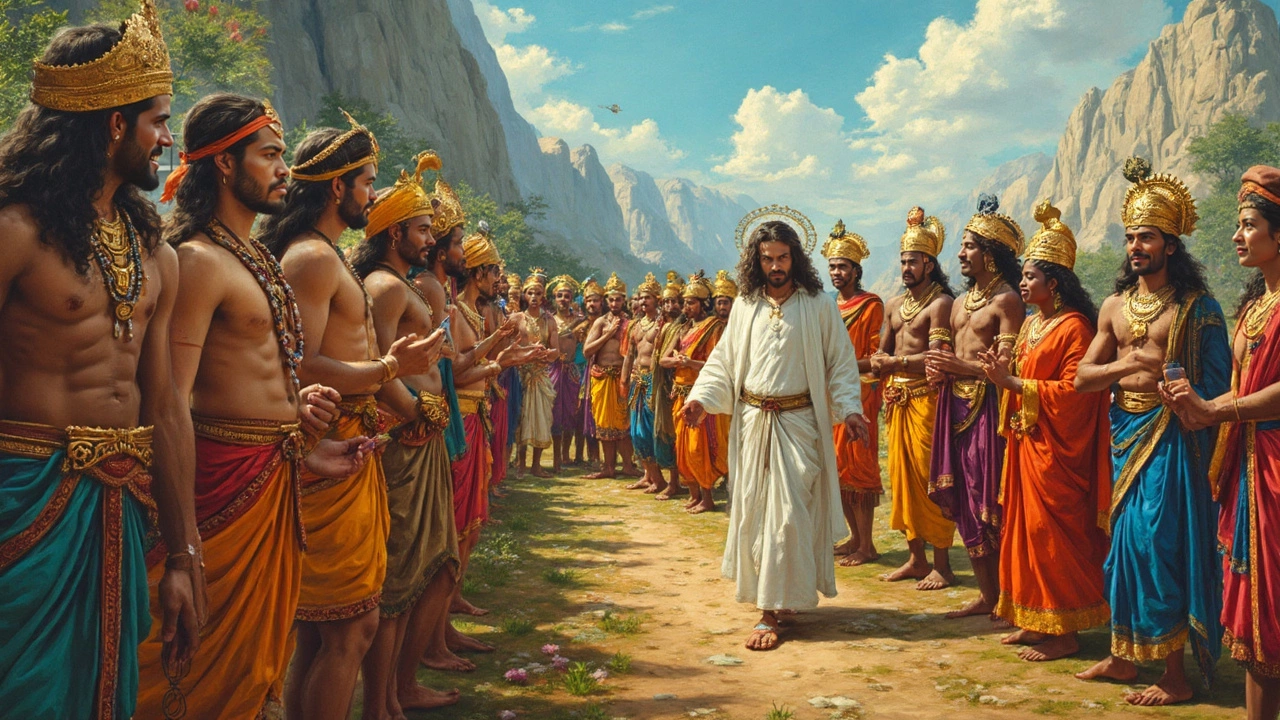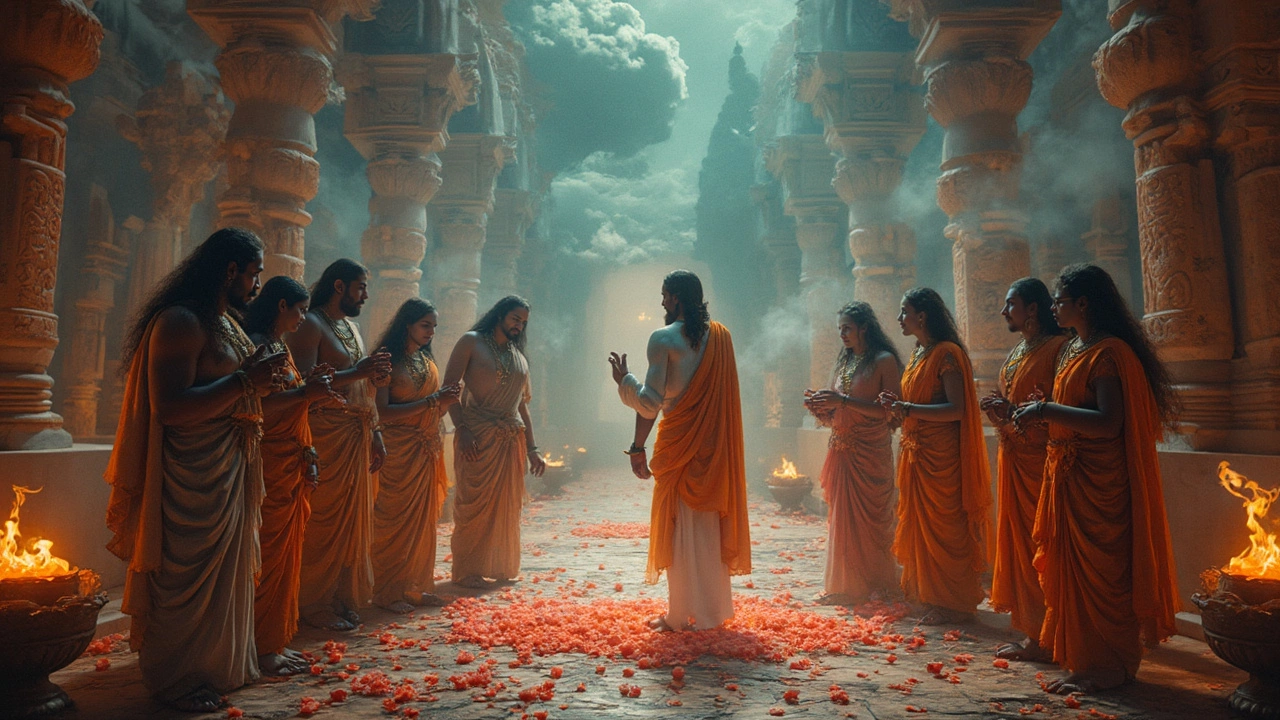Have you ever wondered how different cultures perceive figures from other religions? In a country as diverse as India, it's fascinating to see how various beliefs intertwine. When it comes to Jesus, Hindus have an interesting take that blends respect, curiosity, and a touch of mythology.
Hindus don't traditionally worship Jesus in the same way Christians do, but he's often seen as a wise teacher or a divine figure. This perception rises not just from religious texts but from centuries of cultural exchange between the East and the West. If we dive into Indian mythology, some stories even weave Jesus into their narrative, illustrating the universal longing to connect human experiences.
Understanding these perspectives isn't just about religion; it's a way to appreciate cultural syncretism—how different beliefs can coexist and enrich each other. This kind of mutual respect opens doors to broader dialogues about spirituality, faith, and human connection, making it all the more intriguing for anyone keen on exploring global belief systems.
- Introduction to Hindu Views on Jesus
- Comparative Religious Perspectives
- Jesus in Indian Mythology
- Influence of Christianity in India
- Cultural Exchange and Adaptation
- Modern Interpretations and Views
Introduction to Hindu Views on Jesus
In India, a land where spirituality runs deep, the figure of Jesus often sparks curiosity and respect among Hindus. Rather than a strict doctrinal approach, Hindus see Jesus as more than just a historical figure; he's viewed through various cultural lenses that emphasize his teachings and divine essence.
One might ask how Jesus, predominantly a Christian figure, holds a place in Hindu perceptions. It's important to note that Jesus is seen as a wise teacher, akin to a guru or a great sage. While Hindus have a myriad of deities and teachers, Jesus' teachings about love and compassion resonate well with Hindu philosophies.
Religious Philosophies and Syncretism
Historically, Christianity in India dates back to the first century AD, believed to have been brought by Apostle Thomas. This ancient connection laid the groundwork for mutual respect between Hindus and Christians. A blend of religious ideologies fostered acceptance and respect.
“The Earth is my Mother, and I am her son” - Vedic Hymn, often parallels the message of belonging and universality found in the teachings of Jesus.
In Hindu society, where mythology and narratives hold significant sway, Jesus is sometimes woven into stories as a symbol of spiritual harmony. For example, some interpretations equate him with earlier avatars, bridging the gap between different religious teachings.
Despite varying interpretations, there's a shared focus on the moral and ethical teachings of Jesus. The core values he preached—like empathy, forgiveness, and humility—align well with Hindu teachings, making his philosophy timeless and relatable.
Comparative Religious Perspectives
When we look at how Hindus and Christians view Jesus, there's more overlap than you might expect. For Christians, of course, Jesus is the cornerstone of their faith—a savior, the Son of God, and a figure of paramount spiritual significance. Hindus, on the other hand, don't see Jesus in strictly theological terms, but rather as a profound teacher and possibly a divine incarnation.
One reason for this complementary viewpoint is Hinduism's flexible approach to spirituality. It's common in Hindu beliefs to recognize divinity in numerous forms. Figures like Krishna and Rama, who are also considered divine incarnations in Hindu texts, can provide a similar framework to understand Jesus. This adaptability allows many Hindus to accept Jesus as another avatar or holy messenger.
Similarities in Teachings
There's a parallel in the teachings of Jesus and Hindu philosophical ideas, especially when it comes to love, compassion, and selflessness. The Sermon on the Mount, for instance, shares vibes with the values taught by ancient Hindu scriptures like the Bhagavad Gita, where themes of forgiveness, charity, and devotion are prominent.
Historical Interactions
Let's not forget the historical interactions between Hindus and Christians through centuries of trade and learning. When Portuguese and British traders, and later colonial administrators, introduced Christianity to India, it wasn't a one-way street. Indians, including Hindus, were curious and engaged with these new ideas, contributing to a shared understanding.
| Concept | Hinduism | Christianity |
|---|---|---|
| Divine Incarnations | Multiple Avatars | Jesus as the Son of God |
| Key Teachings | Dharma and Karma | Love and Forgiveness |
This blended sense of spirituality shows up in modern interpretations too, where elements of harmony and coexistence are emphasized. It's a dynamic that not only enriches personal beliefs but also fosters peaceful interaction between communities.
Jesus in Indian Mythology
When people talk about intertwining stories from different cultures, Jesus turning up in Indian mythology may come as a surprise to some. But it's not unheard of. This isn't about Jesus being directly worshipped but rather how his stories and teachings find a place in one's spiritual understanding.
Historically, contact between India and the Western world over centuries allowed for various cultural and religious exchanges. One notable example is the association of Jesus with a revered personality known as Issa. Some ancient texts and folkloric tales suggest Jesus lived in India during his so-called 'lost years'. Before diving into these, it’s crucial to understand they often carry more myth than historical proof.
The Lost Years
Many believers and scholars have speculated about the unaccounted years of Jesus' life—those years between his childhood and the beginning of his ministry. According to some narratives, Jesus traveled to India, learning from different sages and spiritual leaders. Whether historically accurate or not, these stories highlight the interconnectedness people see between faiths.
Shirdi Sai Baba Similarities
A more recent tale pairs Jesus with the famed Shirdi Sai Baba. Sai Baba, known for preaching love, forgiveness, and religious unity, represents a fusion of Hindu and Muslim traditions, mirroring the universal virtues attributed to Jesus.
People who follow these narratives often refer to similarities in their teachings rather than specific events or parables. It’s an understanding that sees Jesus as a universal figure, not confined to one religious tradition, emphasizing themes like love, sacrifice, and the quest for truth—principles cherished in Hindu philosophy too.
Such stories, myths, or beliefs form the basis of a cultural dialogue that allows diverse spiritual doctrines to share ideas and interpretations, ultimately enriching the world's tapestry of faith.

Influence of Christianity in India
Christianity in India is not just an import from distant lands; it has roots that go back nearly two millennia. The arrival of Christianity is often attributed to Saint Thomas, one of the apostles of Jesus, who is believed to have reached the Kerala coast around 52 A.D. Can you imagine that kind of historical deep dive?
The early Christian community in Kerala, known as the Saint Thomas Christians, integrated into the local culture while still preserving distinct traditions. This set the tone for how Christianity would continue to spread throughout India. Over the centuries, especially during European colonial times, the influence of Christianity grew. Various missionaries and colonial powers like the Portuguese, Dutch, French, and British expanded the Christian footprint across the subcontinent.
Impact on Indian Culture
Hindus and Christians in India have learned to coexist, which is a testament to the country’s cultural acceptance. This coexistence has resulted in some lively cultural exchanges. Have you noticed that Christmas is celebrated with gusto even in predominantly Hindu areas? Bright lights, decorated trees, and Santa on sleighs aren’t just a Western thing anymore!
Christian practices and beliefs have also found their way into Indian culture, sometimes altering social customs and introducing new educational approaches. Missionary schools are respected for their academic rigor, contributing to India's educational landscape.
Christian Population and Diversity
India is home to approximately 28 million Christians, making up about 2.3% of the population. These communities are incredibly diverse, ranging from Roman Catholics to various Protestant denominations, and they are spread throughout the country.
| Region | Christian Population (%) |
|---|---|
| Kerala | 18% |
| Tamil Nadu | 6% |
| Goa | 25% |
| Northeast India | 30-50% |
In regions like North-East India, Christianity is the predominant religion. Here, it has helped forge a unique cultural identity, blending local traditions with Christian beliefs. This diversity highlights how adaptable and inclusive religions can be, influencing and absorbing local cultures at the same time.
Overall, the impact of Christianity has been significant, creating a rich tapestry of blended beliefs and shared festivals that add to the vibrancy of Indian culture.
Cultural Exchange and Adaptation
India is a melting pot of cultures, and over time, it has embraced influences from around the world, including Christianity. The cultural exchange between India and Western countries where Christianity is predominant started with traders, travelers, and later colonialists. But it wasn't just a one-way street; both cultures adapted, borrowed, and found common ground.
The legacy of this exchange is visible in various areas like festivals, architecture, and even cuisine. For instance, the celebration of Christmas has found its place in Indian society, often adapted with local flavors and traditions. Many Hindus participate in Christmas celebrations, embracing it as a secular festival of joy and togetherness.
On a spiritual level, Hinduism's inclusive nature has allowed it to accommodate beliefs from Christianity. This is reflected in movements like the Brahmo Samaj and the works of Swami Vivekananda, who drew parallels between Jesus' teachings and those of Hindu sages.
Influence on Art and Literature
Indian literature and art have also reflected this exchange. Artists have portrayed Jesus in Indian attire, blending elements of local artistic styles with biblical themes, making these artworks both unique and reflective of cultural harmony. In literature, stories weave Christian teachings with Hindu concepts, creating narratives that resonate with a broader audience.
To visually understand this exchange, let’s consider how these interactions manifest:
| Aspect | Hindu Adaptation |
|---|---|
| Festivals | Christmas celebrations with Diwali decorations |
| Education | Christian schools incorporating Vedic lessons |
| Art | Indian Jesus portraits with traditional attire |
These examples show how cultural adaptation goes beyond mere acceptance. It's about creating something new from the threads of existing traditions, which makes the coexistence of Hindu and Christian elements in Indian mythology and culture truly fascinating.
Modern Interpretations and Views
Today, the coexistence of Hindus and Christians in India presents a unique perspective on how Jesus is viewed in modern times. In this globalized world, religious boundaries blur, leading to an enriching blend of beliefs and traditions.
Many Hindus regard Jesus as a wise teacher, similar to their gurus or sages. This admiration isn't about religious conversion but more about appreciating the teachings of love, compassion, and forgiveness—values that resonate strongly in Hinduism too. Temples and spiritual centers might feature his teachings, especially during interfaith events promoting communal harmony.
Global Influences
The spread of yoga and meditation worldwide has also led to people exploring other spiritual paths, including Christianity, with an open heart. This cultural exchange means stories from Indian mythology sometimes intertwine with Jesus's tale, bringing refreshing interpretations to the stories of both faiths.
Contemporary Media and Culture
Contemporary Indian movies and books occasionally portray Jesus in a mystical context, intertwining his life with modern myths. This isn’t about adopting a new deity but rather about storytelling that celebrates shared human values.
By understanding these modern interpretations, we see a broader cultural tapestry where Jesus's figure transcends traditional boundaries. This shows a growing openness to the wisdom imparted by spiritual figures, regardless of religious origins, fostering a community united by core human values.
In this context, modern Hindus often engage with Jesus's teachings through literature, dialogues, and personal reflection, nurturing a bond not solely rooted in religious identity but shared respect and understanding across different faiths.
